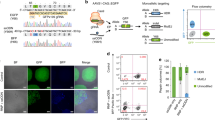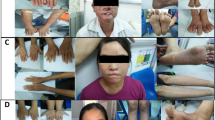Abstract
Various oligonucleotide (ODN)-based approaches have been proposed for their ability to correct mutated genes at the normal chromosomal locations. However, the reported gene correction frequencies of these approaches have varied markedly in different experimental settings, including when different tissues or cell types are targeted. In order to find the optimal ODN-based approach for a specific target tissue, an assay system that allows direct comparison of the different methods on that tissue is necessary. Herein, we describe an XP-UVC selection assay that can be used to evaluate and compare gene correction frequencies in different cell types obtained from a xeroderma pigmentosum (XP) patient, following treatment by different ODN-based approaches. As an experimental example, the XP-UVC selection assay was used to assess the ability of chimeric RNA/DNA ODN to correct point mutations in the XPA gene. This assay can be used to assess and evaluate other types of ODN-based approaches, and to further optimize them.
This is a preview of subscription content, access via your institution
Access options
Subscribe to this journal
Receive 12 print issues and online access
$259.00 per year
only $21.58 per issue
Buy this article
- Purchase on Springer Link
- Instant access to full article PDF
Prices may be subject to local taxes which are calculated during checkout





Similar content being viewed by others
References
Liu CM, Liu DP, Liang CC . Oligonucleotide-mediated gene repair at DNA level: the potential applications for gene therapy. J Mol Med 2002; 80: 620–628.
Andersen MS, Sorensen CB, Bolund L, Jensen TG . Mechanisms underlying targeted gene correction using chimeric RNA/DNA and single-stranded DNA oligonucleotides. J Mol Med 2002; 80: 770–781.
Nickerson HD, Colledge WH . A comparison of gene repair strategies in cell culture using a lacZ reporter system. Gene Therapy 2003; 10: 1584–1591.
van der Steege G et al. Persistent failures in gene repair. Nat Biotechnol 2001; 19: 305–306.
Graham IR et al. Gene repair validation. Nat Biotechnol 2001; 19: 507–508.
Diaz-Font A et al. Unsuccessful chimeraplast strategy for the correction of a mutation causing Gaucher disease. Blood Cells Mol Dis 2003; 31: 183–186.
Zhang Z et al. Failure to achieve gene conversion with chimeric circular oligonucleotides: potentially misleading PCR artifacts observed. Antisense Nucleic Acid Drug Dev 1998; 8: 531–536.
Moriwaki S, Kraemer KH . Xeroderma pigmentosum – bridging a gap between clinic and laboratory. Photodermatol Photoimmunol Photomed 2001; 17: 47–54.
Friedberg EC . Xeroderma pigmentosum, Cockayne's syndrome, helicases, and DNA repair: what's the relationship? Cell 1992; 71: 887–889.
Hoeijmakers JH . Human nucleotide excision repair syndromes: molecular clues to unexpected intricacies. Eur J Cancer 1994; 30A: 1912–1921.
Hanawalt PC . Transcription-coupled repair and human disease. Science 1994; 266: 1957–1958.
Sancar A . Mechanisms of DNA excision repair. Science 1994; 266: 1954–1956.
van Steeg H, Kraemer KH . Xeroderma pigmentosum and the role of UV-induced DNA damage in skin cancer. Mol Med Today 1999; 5: 86–94.
Levy DD, Saijo M, Tanaka K, Kraemer KH . Expression of a transfected DNA repair gene (XPA) in xeroderma pigmentosum group A cells restores normal DNA repair and mutagenesis of UV-treated plasmids. Carcinogenesis 1995; 16: 1557–1563.
Jones CJ, Wood RD . Preferential binding of the xeroderma pigmentosum group A complementing protein to damaged DNA. Biochemistry 1993; 32: 12096–12104.
Miyamoto I et al. Mutational analysis of the structure and function of the xeroderma pigmentosum group A complementing protein. Identification of essential domains for nuclear localization and DNA excision repair. J Biol Chem 1992; 267: 12182–12187.
States JC, Myrand SP . Splice site mutations in a xeroderma pigmentosum group A patient with delayed onset of neurological disease. Mutat Res 1996; 363: 171–177.
Satokata I et al. Genomic characterization of the human DNA excision repair-controlling gene XPAC. Gene 1993; 136: 345–348.
Satokata I, Tanaka K, Okada Y . Molecular basis of group A xeroderma pigmentosum: a missense mutation and two deletions located in a zinc finger consensus sequence of the XPAC gene. Hum Genet 1992; 88: 603–607.
Kraemer KH et al. Effects of 8-methoxypsoralen and ultraviolet radiation on human lymphoid cells in vitro. J Invest Dermatol 1981; 76: 80–87.
Kraemer KH, Waters HL . Effects of psoralens plus ultraviolet radiation on human lymphoid cells in vitro. Natl Cancer Inst Monogr 1984; 66: 221–223.
Satokata I et al. Three nonsense mutations responsible for group A xeroderma pigmentosum. Mutat Res 1992; 273: 193–202.
Yoon K, Cole-Strauss A, Kmiec EB . Targeted gene correction of episomal DNA in mammalian cells mediated by a chimeric RNA. DNA oligonucleotide. Proc Natl Acad Sci USA 1996; 93: 2071–2076.
Cole-Strauss A et al. Correction of the mutation responsible for sickle cell anemia by an RNA–DNA oligonucleotide. Science 1996; 273: 1386–1389.
Rice MC et al. Isolation of human and mouse genes based on homology to REC2, a recombinational repair gene from the fungus Ustilago maydis. Proc Natl Acad Sci USA 1997; 94: 7417–7422.
Modrich P, Lahue R . Mismatch repair in replication fidelity, genetic recombination, and cancer biology. Annu Rev Biochem 1996; 65: 101–133.
Kolodner R . Biochemistry and genetics of eukaryotic mismatch repair. Genes Dev 1996; 10: 1433–1442.
Pierce EA et al. Oligonucleotide-directed single-base DNA alterations in mouse embryonic stem cells. Gene Therapy 2003; 10: 24–33.
Alexeev V, Igoucheva O, Yoon K . Simultaneous targeted alteration of the tyrosinase and c-kit genes by single-stranded oligonucleotides. Gene Therapy 2002; 9: 1667–1675.
Emmert S, Kobayashi N, Khan SG, Kraemer KH . The xeroderma pigmentosum group C gene leads to selective repair of cyclobutane pyrimidine dimers rather than 6-4 photoproducts. Proc Natl Acad Sci USA 2000; 97: 2151–2156.
Protic-Sabljic M, Kraemer KH . One pyrimidine dimer inactivates expression of a transfected gene in xeroderma pigmentosum cells. Proc Natl Acad Sci USA 1985; 82: 6622–6626.
Author information
Authors and Affiliations
Rights and permissions
About this article
Cite this article
Terunuma, A., Ye, J., Emmert, S. et al. Ultraviolet light selection assay to optimize oligonucleotide correction of mutations in endogenous xeroderma pigmentosum genes. Gene Ther 11, 1729–1734 (2004). https://doi.org/10.1038/sj.gt.3302344
Received:
Accepted:
Published:
Issue Date:
DOI: https://doi.org/10.1038/sj.gt.3302344



